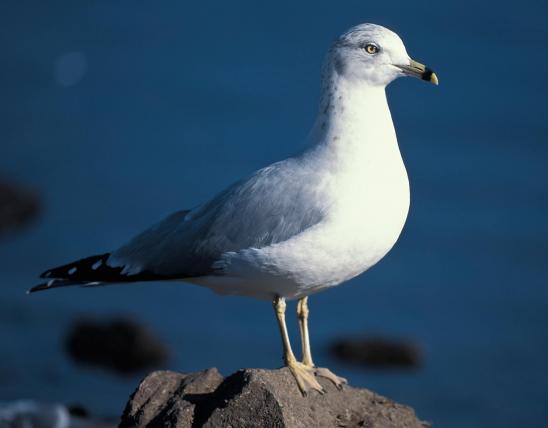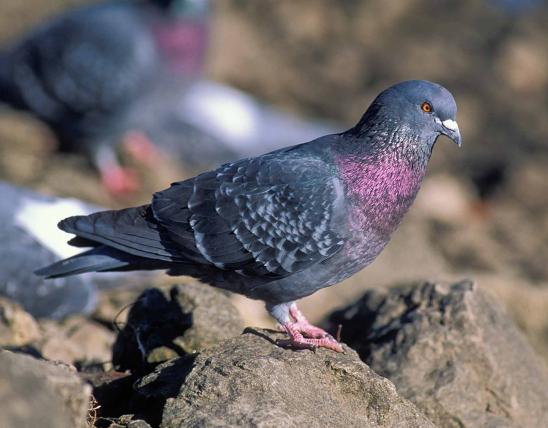
Bonaparte’s gulls occur in Missouri during spring and fall migration and, less commonly, in winter. Like other gulls, they look different during different life stages, and they have different seasonal plumage patterns. Breeding adults have black heads. Other times, the head is white except for a smudgy black spot behind the eye. Wing markings are also helpful for identification.
Adult Bonaparte’s gulls in flight have a large, narrow white triangle in the outer primary wing feathers (widening from the “elbow” to the outer tip), and the outer trailing edge of the wing has a thin black line. In breeding plumage, adults have a black head; the bill is small and black, and the legs are red. In wintertime nonbreeding plumage, the head is white and there is a dark patch behind the eye; the legs turn pink.
Immatures resemble winter adults but have a black bar across the wings (“shoulder”) (visible at rest and in flight), a black trailing edge along the whole wing, and a black band at the end of the tail. In flight, from above, the outstretched wings of young birds appear to have a dark, wide-stretched M spreading from wingtip to wingtip.
The call is a harsh, scratchy “cherrr,” or “kheh,” somewhat like a Forster’s tern but lower in pitch.
Similar species:
Adult breeding Franklin’s gulls have black heads but have split, white eye rings and red, not black bills; in winter, the head has a darkened half-hood (not a dark cheek spot).
Two rare gulls to be looked for in winter flocks of Bonaparte’s gulls are the little gull and the black-headed gull. These two gulls have established breeding colonies in North America, expanding their range from the Eastern Hemisphere. Both have adult plumage with black heads, and nonbreeding plumage with dark smudges behind the eye. Also, both are similar in size to the Bonaparte’s gull: the little gull is 2 inches shorter and the black-headed is 2 inches longer. Here’s how to quickly spy them among Bonaparte’s gulls:
- The little gull stands out in a flock of Bonaparte’s gulls because of its dark underwing linings.
- The black-headed gull has a red bill and legs, and viewed in flight, the outer part of the underwing is dark.
The agile flight of Bonaparte’s gulls can make them seem like terns. Their grating calls are more like those of terns than of typical gulls.
Because they can be so common and come in so many color forms, rock pigeons having white plumage could possibly be confused with Bonaparte’s gulls. But the pigeons are much smaller (smaller than a crow), with chunkier bodies, shorter and wider wings, proportionately smaller heads, and shorter bills. Also, pigeons do not float and paddle around on water as gulls do.
Length: 13½ inches (tip of bill to tip of tail); wingspan 33 inches. They are about the same size as a crow, which is very small, for a gull.
Statewide in appropriate habitats; in winter, more commonly seen in southern Missouri.
Habitat and Conservation
As with other gulls found in our state, Bonaparte’s gulls usually stick to lakes and large rivers, but they occasionally are seen in agricultural fields, especially along big rivers and near large bodies of water.
During the coldest parts of winter, usually from mid-January to early February, the big rivers and lakes to the north of Missouri freeze. Gulls move south, staying near the southern edge of the ice. This is the time of year when several species of gulls — some of them rare — can be seen in our state. Birders look for common and rare gulls anywhere in the state where gulls congregate. Some of the wintertime hotspots are near the locks and dams on the Mississippi River, near dams on large reservoirs, and at large landfills.
Food
Forages over lakes and large rivers for small fish swimming just under the surface, and for flying insects. This species changes its diet over the course of a year, feeding more heavily on insects during breeding season, and in winter on fish (plus, along seacoasts, small crustaceans, mollusks, and marine worms).
Status
Common transient; accidental summer visitor; as winter resident, uncommon in southern Missouri locally and rare in northern Missouri.
Life Cycle
Present in Missouri from late September to late May; populations are highest in November and from April to early May.
The breeding range of Bonaparte’s gulls is in the boreal forests in northern sections of Canada and Alaska. The winter range is along the Pacific, Gulf, and Atlantic coasts, the Caribbean, and inland into much of the southeastern United States. The Bootheel and southern edge of Missouri is counted in the winter territory.
Remarkably, this is the only gull that normally nests in trees, though it sometimes nests on the ground. In their boreal Canadian and Alaskan breeding territory, Bonaparte’s gulls nest in marshy areas or stream edges. The nests are usually positioned on horizontal branches near the trunk of coniferous trees. They are shallow bowls built of twigs and bark and are lined with mosses, grasses, and lichens. There is only 1 brood a year; the clutch comprises 2 or 3 eggs, which are incubated for 22–25 days. After hatching, the young remain in the nest for about a week. Lifespan may be 18 years.
Human Connections
The common name of this gull honors the French-born ornithologist Charles Lucien Bonaparte (1803–1857), who spent several years in North America. A nephew of the French ruler Napoleon I, he made significant contributions to scientific knowledge about American birds and named hundreds of species. He was also a champion of the young John James Audubon. He spent much of his life as a resident of Italy, traveled throughout Europe working with museum bird collections, and eventually was allowed to return to France. There, in 1854, he became the head of the Jardin des Plantes in Paris, the nation’s premier botanical garden and now, with expansion, considered the “Louvre of the Natural Sciences.”
The genus name, Chroicocephalus, is from Greek roots meaning “colored head,” referring to the dark-colored masks or hoods on many of the members of this genus. The species name, philadelphia, refers to the place where the original scientific (type) specimen was collected.
Members of the gull family are gregarious, intelligent, inquisitive, and resourceful. They can be loud, many are comfortable around people, and they forage for many foods that humans find revolting. People who live on seacoasts and along the Great Lakes often disdain gulls, but for those of us in landlocked places, they can represent the sunny, carefree coasts where we’d like to vacation.
Ecosystem Connections
Bonaparte’s gulls play a role in limiting the populations of all the creatures they eat, including insects and fish. Gulls are preyed upon themselves, especially as eggs and juveniles. Nesting in trees no doubt helps these small gulls avoid egg predators. Meanwhile, windstorms may cause eggs to be blown out of nests, so there can be a fine balance between potential benefits and risks.
This species stands to lose more than 80 percent of its breeding range, if climate change continues unchecked. A warming climate will change the boreal forests in northern North America making most of the region unsuitable for these gull’s needs — and there is little territory to the north of it for them to shift to.
The interconnections with habitats and other species are many. Like other migratory species, Bonaparte’s gulls need healthy habitats in both winter and summer territories. They also need appropriate, healthy habitats in all the places they pass through during migration. For example, at breeding time, they need plenty of wetland or streamside coniferous trees to nest in, mosses and lichens to line their nests with, and abundant insects to eat and feed their young.








About 350 species of birds are likely to be seen in Missouri, though nearly 400 have been recorded within our borders. Most people know a bird when they see one — it has feathers, wings, and a bill. Birds are warm-blooded, and most species can fly. Many migrate hundreds or thousands of miles. Birds lay hard-shelled eggs (often in a nest), and the parents care for the young. Many communicate with songs and calls.



























